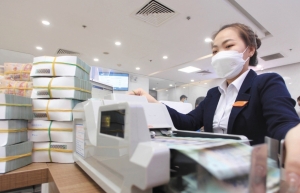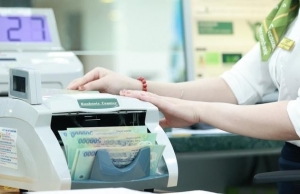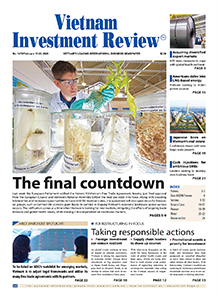Non-performing loans pose challenge to banking sector
Hanoi-based Viet Dragon Securities Company (VDSC) forecasts that NPLs could increase slightly in 2025 following a State Bank of Vietnam scheme (Circular 2) to reschedule debt and assist borrowers in difficulties that expired at the end of 2024.
 |
| Photo: baodautu.vn |
As of the end of August 2024, rescheduled loans approximated $5.04 billion.
VDSC estimates that the potential NPL volume (including rescheduled loans, unresolved loans at state-owned ‘bad debt bank’ VAMC, and extended corporate bonds) at the end of Q3, 2024 approximated 70 per cent of the banking system's on-balance-sheet NPLs, raising concerns that a portion of this debt could become NPLs in 2025.
VDSC, however, believes that the increase in NPLs after Circular 02 expires will not significantly affect the ability to control on-balance-sheet NPLs, as banks have already set aside relatively sufficient provisions.
Additionally, the central bank (SBV) has allowed loans affected by Typhoon Yagi to be restructured and retain their loan group status until the end of 2026.
Cao Viet Hung, head of the financial analysis division at ACB Securities (ACBS), said although there will still be a slight increase in NPLs over the last two quarters of 2024, there are signs that NPLs may have peaked and could improve in 2025.
According to Hung, the most difficult period for the banking sector has passed, and the NPL ratio of banks in their observation portfolios is expected to decrease to 1.5 per cent by the end of 2025, from 1.6 per cent at the end of 2024.
However, the relatively low level of provisioning during 2023–2024 means that provisioning pressure will remain high in 2025.
Provisioning buffers of banks have also fallen, and there is a clear distinction between banks. Smaller private banks generally have lower provisioning buffers compared to state-owned banks.
Statistics from the fourth quarter of 2024 for 27 banks show that 13 had a lower NPL coverage ratio compared to the end of 2023.
Fourteen banks reported an increase in NPL coverage ratios over the past year, with only four banks – Vietcombank, VietinBank, BIDV, and Techcombank – maintaining coverage ratios above 100 per cent.
MBS, however, has a more optimistic outlook, forecasting that credit growth in 2025 will come to around 17-18 per cent.
Asset quality will continue improving in 2025, helping to ease the pressure of rising NPLs.
In 2025, MBS experts forecast that provisioning expenses for banks in the monitored group will increase by 16.9 per cent, with state-owned banks experiencing lower growth of 12.6 per cent, as their credit is primarily focused on businesses.
According to data from the SBV, by the end of 2024, the total amount of Group 2 loans – those showing signs of potential risk – at banks had surpassed $8.46 billion, accounting for 1.25 per cent of total outstanding loans.
This figure had decreased by 7 per cent compared to the end of 2023. Among them, joint-stock banks accounted for the majority, with more than $4.75 billion, or 56.1 per cent of Group 2 loans in the system.
The on-balance-sheet NPLs of banks at the end of 2024 exceeded $29.3 billion, up 3.4 per cent compared to the end of 2023.
The SBV also pointed out some banks with on-balance-sheet NPL ratios above the 3 per cent threshold, including MBV at 7.18 per cent, GPBank at 15.87 per cent, DongA Bank at 46.1 per cent, NCB at 16.69 per cent, and SCB at 98.5 per cent.
Among these, MBV, GPBank, VCBNeo, and DongA Bank have been subject to compulsory transfers, while SCB is under special control.
SBV leaders stated that the bank is actively addressing NPLs and restructuring the banking system. Four weak banks have been transferred, but there are still many outstanding debts that need to be resolved.
To support this process, the SBV has presented the government with a proposal for special loans to weak banks and recommended that the government consider legislating a pilot plan to handle NPLs and create a stronger legal framework for NPL settlement, ensuring financial stability.
 | NPL landscape hinges on renewal of credit circular While extending a circular on credit, institutional loan repayment rules may provide short-term relief for both borrowers and banks amid weak domestic demand and a sluggish recovery in real estate, it could also obscure the true state of non-performing loans. |
 | Banks continue massive bond issuances in early 2025 The banking sector is continuing to play a key role in the corporate bond market to replenish capital sources and support growth. |
 | Banks expect upbeat profit picture for 2025 Several banks have set higher profit targets for this year, expecting more positive credit growth amid improved capital absorption capacity and an acceleration of public investment. |
What the stars mean:
★ Poor ★ ★ Promising ★★★ Good ★★★★ Very good ★★★★★ Exceptional
 Tag:
Tag:
Related Contents
Latest News
More News
- Long-term capital seen as key hurdle to green growth (December 16, 2025 | 08:00)
- Gold prices swing amid tax debate and import uncertainty (December 15, 2025 | 18:04)
- Agribank frames bank credit as catalyst for green growth (December 15, 2025 | 17:59)
- Vietnam’s green transition demands collective financial action (December 15, 2025 | 12:00)
- VIR workshop highlights capital and policy for sustainable development (December 15, 2025 | 11:00)
- Promoting digital assets initiative in Vietnam (December 13, 2025 | 09:30)
- Experts flag gaps as national financial strategy under review (December 12, 2025 | 15:13)
- Global gold exchange models offer roadmap for Vietnamese market (December 12, 2025 | 11:58)
- Five million household businesses to adopt self-declared tax system (December 11, 2025 | 18:13)
- Vietnam establishes management board for crypto asset trading market (December 11, 2025 | 18:11)






























 Mobile Version
Mobile Version